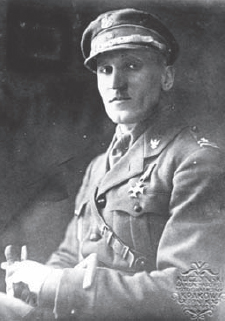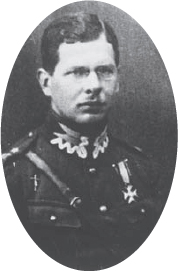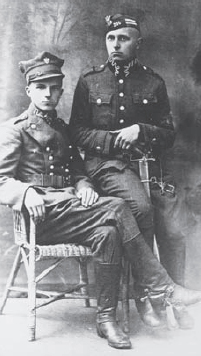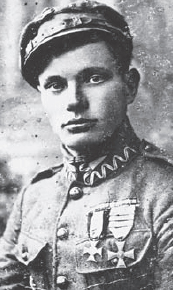
Unified Polish Army uniform regulations were published on 1 Nov 1919 but took until mid-1920 to implement, and many Polish troops reached the Oct 1920 armistice still wearing all or some of their pre-1919 uniforms, insignia and equipment. The practical but elegant M1919 uniform was in ‘grey-greenish-brown’ – a greenish dark khaki cloth – and silver buttons bore a Polish eagle with pointed wings.
The M1919 officers’ and WOs’ rogatywka service cap had a loose crown pulled over the right ear; an M1917 eagle with unit number on the shield on the front of the crown, above rank insignia on the band; a brown leather chinstrap with a silver buckle and matching peak with silver edging; and silver (WOs, dark red) piping around the top of the khaki band, along the four vertical seams and forming a cross on the square crown. The NCOs’ and privates’ cap had no piping, and initially the eagle was placed lower astride the crown and band; but on 11 Feb 1920, NCOs and lance-corporals moved the eagle up to the crown to accommodate new rank insignia on the band. The plain khaki peakless field cap had small rank badges on the left front. The French M1915 Adrian steel helmet was worn with an eagle-and-shield plate.
The M1919 officers’ khaki 5-button tunic had a stand-and-fall collar, with branch-colour patches bearing zigzag silver braid (see below, ‘Branch distinctions’); pointed shoulder straps bearing rank and unit insignia; two pleated external breast pockets and two large external waist pockets, all with square, buttoned flaps; and a sewn turnback buttoned cuff. NCOs and privates had no breast pockets, and internal waist pockets with diagonal, buttoned flaps.

Major dyplomowany (Major, General Staff trained) Jerzy Grobicki, officer commanding 1st ‘Józef Piłsudski’ Light Horse Regt (15 August 1920–8 May 1921). Photographed in September 1920, Grobicki still wears an M1917 PSZ cap with officers’ rosette and braid chinstrap. He displays the Virtuti Militari Silver Cross on his non-regulation British-style open-collar French; this has M1919 cuffs, a General Staff silver collar-eagle (as also worn by general officers), but no collar patches or ‘JP’ shoulder-strap monograms. The 1st Light Horse, formed in October 1918, were the élite Polish cavalry regiment; Grobicki led them at Warsaw (9th Cav Bde); and on 17 August at Arcelin, near Płońsk, they charged Russian forces and took 800 prisoners. (Polish Institute & Sikorski Museum, London)
The khaki 6-button greatcoat had a wide turn-down collar with diagonal cloth bars in branch colour; shoulder straps with rank and unit insignia; deep sewn turnback cuffs with a flap and two buttons; two internal waist pockets with buttoned, vertical flaps; a 4-button rear vent, and two buttoned rear tabs to support the equipment belt.
Officers wore khaki breeches with black leather riding boots, or three-buckle leggings with ankle boots; or trousers with black leather shoes. Generals wore dark blue piping between two wide dark blue stripes.

Lieutenant Brochocki of the 13th Lancers in service uniform, showing the M1919 uniform with M1920 regimental collar pennant badges (here, pink/dark blue/pink), and double-zigzag silver braid. These replaced the M1919 dark red cavalry collar patches in July 1920. The silver wire regimental numeral below his rank star on the shoulder strap was removed from field uniform. As well as the Virtuti Militari Silver Cross on his left breast, the Cross and Polish Eagle commemorating service in I Polish Corps in Russia, 1918, can just be seen on his right breast. Many Polish Tartars served in this regiment. (Polish Institute & Sikorski Museum, London)
Much brown leather equipment was retained from the various pre-1919 Polish forces. Officers’ field equipment comprised a British-style ‘Sam Browne’ waistbelt and crossbrace; an M1917 cavalry sabre with officers’ knot; a Russian M1895 7.62mm Mosin-Nagant or German M1908 9mm Parabellum pistol in a holster on the right front; and a khaki canvas mapcase and binoculars case on the left hip. Riflemen wore a leather belt with steel buckle, support straps, and two sets of rifle ammunition pouches; a frogged bayonet strapped to a spade clipped to the belt on the rear left hip; and a grey canvas breadbag strapped to the back of the belt. The rolled greatcoat was strapped around the khaki canvas backpack, and a khaki-painted messtin was strapped to the rear. Rifles included the French M1886/93 8mm Lebel and M1907/16 7.5mm Berthier, and the Russian M1891 7.62mm Mosin-Nagant.
Highland Infantry wore the M1919 khaki mountain service cap with a silver eagle badge, and a white eagle’s feather tipped red tucked in the band. Cavalry (light horse, lancers and mounted rifles) wore dark blue service-dress riding breeches with regimentally coloured piping and wide stripes. The Tartar Lancer Regiment wore a traditional green short-sleeved, decorated waistcoat over a grey tunic, and red breeches striped white. Air Service flying personnel wore brown or black leather jackets/coats or khaki flying overalls lined with brown fur, and brown leather flying helmets.

Aloizy Sawicki (left) and Jerzy Kulinski of the 214th Reserve Lancer Regt, Volunteer Army, November 1920; both have the single rank bar of lance-corporal on their shoulder straps. Sawicki wears the M1919 Greater Poland field-grey cavalry uniform. His rogatywka shows the M1919 eagle but no trefoil rank insignia, while his tunic has M1917 cavalry zigzag collar braid. Kulinski wears an M1919 khaki peakless field cap with unofficial insignia: an M1919 eagle, silver regimental numerals, and the regiment’s white/orange/white collar pennant. His non-regulation khaki French bears M1917 collar patches and zigzag braid. The 214th Regt, formed in July 1920, fought under 10th Inf Div at the battle of Zamość, 29–30 August; that December it was redesignated 24th Lancer Regiment. (Polish Institute & Sikorski Museum, London)
On the M1919 tunic all ranks wore branch facing-colour collar patches, with scalloped rear edges piped in a contrasting shade; sometimes, a silver metal or wire collar badge; and zigzag silver wire braid on the front and bottom edge (generals, triple; other officers and WOs, double; NCOs and privates, single braid). Former Russian and Greater Poland army cavalrymen retained their pennant collar badges, a practice extended in July 1920 to all cavalry. Silver braid or metal unit numerals and monograms were worn on service-dress shoulder straps but removed from field uniforms. M1919 greatcoat collars showed a horizontal double stripe of piping colour above facing colour, above the collar badge.
General officers wore silver stars arranged horizontally on service-cap band zigzag silver braid; a zigzag braid cuff ring on the tunic; and silver stars above a zigzag bar on field caps. Field officers wore silver stars on the cap band with two silver braids on the upper edge, and silver stars above a single bar on field caps. Subalterns and warrant officers wore silver stars on the cap band and field cap. An officer cadet wore a silver braid chevron point down on the service-cap band; sergeants, 2–1 dark red braid chevrons; lower ranks, 3–1 dark red bars.

Sgt Stanisław Jaworski, 11th Lancers, photographed in 1921, wearing the M1917 PSZ dismounted uniform with maciejowka cap; the officers’ unpiped dismounted tunic has enlisted shoulder straps, single-zigzag silver braid along the front and bottom collar-edges, and M1920 purple/white/purple regimental collar pennants. He displays the Virtuti Militari Silver Cross, and the Military Cross of Valour (three awards) instituted on 11 August 1920. (Polish Institute & Sikorski Museum, London)
Military officials had special rank titles, and wore silver braid insignia on their plain khaki tunic and greatcoat collars and on their circular-crowned peaked caps: major-general equivalent, 1x 4-pointed star and zigzag braid; field officer equivalent, 3–1 stars and two braids; captain equivalent, 3 stars. Chaplains had rank titles but no rank insignia.
Members of key sub-units wore M1917 badges on the left upper sleeves of tunics and greatcoats (officers in gold wire, NCOs and privates in brass) on a branch-colour cloth backing. A representative selection were: infantry/cavalry technical companies/squadrons – crossed axes; infantry/cavalry MG companies/squadrons – five splayed cartridges; infantry assault companies – flaming grenade; infantry/cavalry signals platoons – ‘T’ and lightning flashes; tanks – dragon; armoured trains – winged wheel; air service – gliding eagle.